![]()
![]()
![]()
Use LEFT and RIGHT arrow keys to navigate between flashcards;
Use UP and DOWN arrow keys to flip the card;
H to show hint;
A reads text to speech;
56 Cards in this Set
- Front
- Back
|
Purpose of tactical communication:
|
to serve command
|
|
|
All communications systems must satisfy four basic requirements to be effective:
|
1. Reliability 2. Security 3. Speed 4. Flexibility
|
|
|
Communications Means (6):
|
1 Radio
2 Wire 3 Sound 4 Visual 5 Physical communications includes messenger (foot or motorized) augmented by mail (guard mail or U.S. mail) 6 Data communications, which include all computer and data transmission devices |
|
|
Most secure communication mean:
|
Messenger
|
|
|
Least secure communication mean:
|
Radio
|
|
|
Radio waves travel along
|
the surface of the earth (groundwaves) and up into the
atmosphere (skywaves). |
|
|
Ground waves travel from the ___ ___ along the surface of
the earth |
transmitting antenna
|
|
|
Several factors can affect the distance / range waves travel:
|
• Dense vegetation, mountainous terrain, or dry desert soil can have a negative effect on a ground wave.
• Manmade features, such as buildings, power lines or water towers, can reflect a radio wave into a new direction or absorb the signal. • Severe weather, such as sandstorms, thunderstorms and blizzards, can affect your radio signal. |
|
|
Planning Considerations 4:
|
1 Position your antenna on the military crest.
2 Position your antenna as far back as possible from obstacles in the direction you want to communicate. 3 Plan for and be prepared to use relay/retransmission stations. 4 Select a scheme of maneuver that allows you to avoid or exploit certain obstacles. |
|
|
To reduce an enemies' ability to intercept your transmissions
|
position your antenna so a natural or manmade obstacle is between you and the enemy
|
|
|
Frequencies from approximately 2-12 MHz
|
Can use the property of
"bouncing" the radio signal off the ionosphere and the earth's surface to increase the range of communications. |
|
|
One problem with skywaves is they produce
|
"skip zones" (areas where
the signal does not return to earth) on the earth's surface. |
|
|
Near Vertical Incident Skywave (NVIS) directs the radio wave at a
|
higher angle toward the sky, thus ensuring the reflected wave returns to earth closer to the transmitter and eliminating any skip zones.
|
|
|
NVIS communications can
|
communicate over high obstacles, such as mountains and travel up to 300 miles from the transmitting
radio. |
|
|
High frequency
(HF) 2 to 29.999 MHz Pros, Use, Equipment |
Pros: Lower HF frequencies can
communicate over great distances Used: when long haul communications are necessary Equipment: AN/PRC-150/104, man portable radio • AN/MRC-148/138, vehicle mounted radio |
|
|
Very High Frequency (VHF)
30 to 87.975 MHz Pros/Cons |
Very High
Frequency (VHF) 30 to 87.975 MHz Extends slightly beyond line of sight (LOS) due to diffraction or bending of the signal by the atmosphere • At frequencies in the 30 MHz range, acts like HF ground waves • Range of reliable communications generally no more than 40 km and often depends on ο The power output of the radio ο Terrain ο Atmospheric conditions |
|
|
Very High Frequency (VHF)
30 to 87.975 MHz Used |
Most widely used in infantry
battalions |
|
|
Very High Frequency (VHF)
30 to 87.975 MHz Equipment |
• AN/PRC-119
• AN/VRC-88 • AN/VRC-89 • AN/VRC-90 • AN/VRC-91 • AN/VRC-92 • AN/VRC-145 |
|
|
Ultra High frequency (UHF)225 to 400 MHz Pros/Cons
|
• Strictly line of sight (LOS)
• Unable to bend around obstacles because UHF wavelengths are so small • Range may extend for more than 500 km as long as aircraft is high enough to be within LOS |
|
|
Ultra High frequency (UHF)225 to 400 MHz Used
|
• Ground-to-air communications
• Air-to-air communications |
|
|
Ultra High frequency (UHF)225 to 400 MHz Equipment
|
• AN/PRC-117/113, man-portable
• AN/VRC-103/83, vehicular-mounted |
|
|
SINCGARS
|
Single Channel Ground Air Radio System: Primary MAGTF VHF radio
|
|
|
Frequency Hopping
|
A transmission technique that changes the frequency of a radio channel automatically at a pseudo-random rate common to both to the transmitter and receiver.
|
|
|
The number of frequencies SINCGARS will hop through will vary depending on the __.
SINCGARS will change frequencies __ times hundred a __. |
HOPSET-100-second
|
|
|
The more frequencies in the HOPSET,
|
the more resistant to
electronic warfare the network will be. |
|
|
The five variables required to frequency hop are 5:
|
1. Hop Set 2. Transmission Security Key (TSK) 3. Transmission Encryption Key (TEK) 4. Time 5. Net Identifier (Net ID)
|
|
|
Hop Set:
|
The VHF frequencies that SINCGARS will hop through in
Frequency Hopping mode |
|
|
Transmission Security Key (TSK):
|
The sequence in which the radio will hop within a HOPSET. It does not encrypt the signal or transmission
|
|
|
Transmission Encryption Key (TEK):
|
Encrypts and decrypts the
operator’s voice during the radio transmission. |
|
|
Net Identifier (Net ID):
|
3-digit numeric code that determines where a specific frequency-hopping (FH) circuit begins frequency-hopping. This will be entered by the radio operator and it will correspond to a specific frequency within the hopset.
|
|
|
AN/VRC-88
|
• 10-km range due to lack of power amplifier
• May be operated while ο Mounted in a vehicle Cο In a dismounted (man-pack) configuration RT:1, RA:0 |
|
|
AN/PRC-119
|
Man-packed SINCGARS
• 200m – 400m in lower power setting • 400m – 5km in medium power • 5km – 10km in high power RT:1, RA:0 |
|
|
AN/VRC-90
|
• Long-range, vehicle-mounted radio set with one power amplifier
• Used where the communication range must normally operate over long distances (up to 40 km) RT:2, RA:1 |
|
|
AN/VRC-89
|
• A vehicle-mounted, dual configuration set of radios
• Consists of one ο Short-range radio without a power amplifier ο Long-range radio with a power amplifier • Provides long-range (up to 40 km) and short-range (up to 10 km) operation in two nets, simultaneously • Has an added power amplifier that provides one of the radio sets with a longrange communication RT:1, RA:1 |
|
|
AN/VRC-91
|
• Vehicle-mounted, dual configuration set
• Consists of one ο Short-range radio, which can be man-packed configured ο Long-range radio • Provides long-range (up to 40 km); and short-range, (up to 10 km) operations in two nets simultaneously • Combines the features of a VRC-88 and VRC-90 into a single vehicle installation RT:2, RA:1 |
|
|
AN/VRC-92
|
• Vehicle-mounted, dual configuration set
• Consists of two long-range radios • Used to meet dual, long-range (up to 40 km) communications requirements • Is a VRC-89 with an additional power amplifier mount to provide communications range up to 40 km to the second radio system • This variation is common in highly mobile units like the artillery battalion, light armored reconnaissance battalion, assault amphibian battalion, and in tank battalion. RT:2, RA:2 |
|
|
AN/MRC-145
|
• Vehicle with mounted, dual configuration set
• Consists of two long-range radios • Used for VHF retransmission and command and control. RT:2, RA:2 |
|
|
Communications Security (COMSEC) is the:
|
protection resulting from all measures designed to deny
unauthorized persons information of value that might be derived from the possession and study of telecommunications or to mislead unauthorized persons in their interpretation of the results of such possession and study. |
|
|
COMSEC is divided into four areas:
|
1. Cryptosecurity 2. Emission security 3. Physical 4. Transmissions security
|
|
|
Essential Elements of Friendly Information (EEFIs) are
|
specific items of
information that, if disclosed, could have a negative impact on friendly operations. This is specifically enforced when transmitting over an unencrypted or “open” net. |
|
|
The EEFI list includes 7:
|
1 Position
2 Capabilities 3 Operations 4 Friendly Electronic Warfare 5 Personnel 6 COMSEC 7 Wrong circuit |
|
|
BEADWINDOW
|
is a procedural word that brings to the immediate attention of circuit operators the fact that an EEFI disclosure has occurred.
|
|
|
Electronic Warfare entails
|
the surveillance of the
electromagnetic spectrum for immediate threat recognition in support of electronic warfare operations and other tactical actions such as threat avoidance, targeting and homing. |
|
|
MIJI Report
|
Meaconing, Intrusion, Jamming and Interference Report
|
|
|
Format for the MIJI Report: TUFT
|
• Time of interference
• Unit affected • Frequency or frequencies affected • Type of interference (jamming, imitative deception, etc.) |
|
|
GINGERBREAD
|
If the enemy is suspected of using imitative electromagnetic deception
|
|
|
Two manual telephones TA-1 and TA-312 with a range of:
|
TA-1: 4 miles
TA-312: 14 to 22 miles |
|
|
• Planning Range: 20+ miles ground wave
• Frequency Range: (HF) 1.6000-59.9999 • Power Sources: BA-5590 (Lithium) 2 each, weight- 1.45 lbs. • Power Output: 1, 5, 20 Watt (Mode Dependent) • Weight: 9.9 lbs. without batteries, 11.35 lbs with batteries • Crypto Unit: Internal COMSEC |
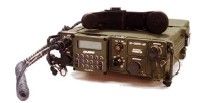
AN/PRC-150 Radio Set
|
|
|
• Planning Range: 30+ miles ground wave (based on antenna employed)
• Frequency Range: (HF) 2 TO 29.9999 MHz • Power Sources: BA-5590 (Lithium) 2 each, weight- 1.45 lbs. • Power Output: ο 20 Watts ο 400 Watts (MRC-138 HMMWV) • Weight: 12.8 lbs without batteries, 15.7 lbs. with batteries • Crypto Unit: KY-99 |
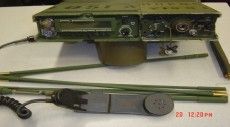
AN/PRC-104 Radio Set
|
|
|
• Planning Range:
ο 200m–400m low power ο 400m–5km medium power ο 5km–10km high power ο 10km–40km power amplifier • Weight: 15.5 lbs without batteries, 16.95 lbs with batteries • Crypto Unit: Internal COMSEC • Frequency Range: (FM) 30-87.975 MHZ • Present Channels: 6 automatic, 1 manual/1 cue for single channel • Power Source: BA-5590 one each, weight 1.45 lbs. • Power Output: ο .5-Watts Low Power ο 2-Watts Medium Power ο 5-Watts High power |
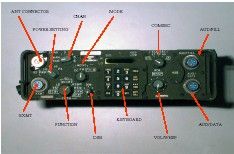
AN/PRC-119 Radio Set
|
|
|
• Transmission Range: UHF- LOS dependent, VHF- 5 to 10 miles, SATCOM- 300
miles (Network and channel access dependent) • Frequency Range: 30.0000-512.0000 • Power Source: BA-5590 (LITHIUM) two each, weight- 1.45lbs • Power Output: 10 Watts (VHF), 20 Watts UHF • Weight: 13.8 lbs without batteries, 16.7 lbs. with batteries • Crypto Unit: Internal COMSEC |

AN/PRC-117 Radio Set
|
|
|
• Transmission Range: VHF- 0 to 5 miles, UHF- LOS dependent
• Frequency Range: 30.0000-512.0000 • Power Source: BA-5123 (3 VDC) • Power Output: 5 Watts • Weight: 2-4 lbs. (Battery type and accessory Dependent) • Crypto Unit: Internal COMSEC |
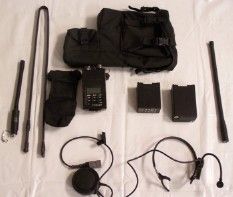
AN/PRC-148 Radio Set
|
|
|
• Transmission Range: Line of Sight (LOS)
• Frequency Range: ο (VHF) 116 TO 149.975 MHz ο (UHF) 225 TO 399.975 MHz • Power Source: BA-5590 (LITHIUM) two each, weight- 1.45 lbs • Power Output: 2-10 WATTS • Weight: 13.8 lbs without batteries, 16.7 lbs with batteries • Crypto Unit: KY-57 |

AN/PRC-113 Radio Set
|
|
|
• Range: 4 miles using WD-1 (slash wire)
• Power: Sound • Signal: Visual and audible ringer • Weight: 4 lbs • Mode of Operation: The TA-1 will operate with other TA-1s, TA-312s and through the SB-22 switch-board. |
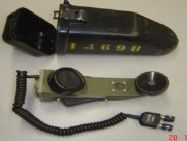
TA-1/PT
|
|
|
• Range: Maximum of 14 to 22 miles based on temperature and relative humidity
• Power: BA-3030s (D Cell batteries) two each • Signal: Audible Ringer • Weight: 10 lbs. • Mode of Operation: The TA-312 will operate with other TA-312s, TA-1s and through the SB-22 switch-board. |
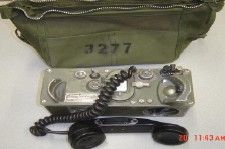
TA-312/PT
|
|
|
provide a 24-hour continuous worldwide, all-weather precise position and time
measurement. • Space segment (satellites) • Control segment (monitor stations on Earth) • User segment (GPS receivers) Referred to as the PLGR or “plugger.” |

AN/PSN-11 Precision Lightweight GPS Receiver (PLGR)
|

